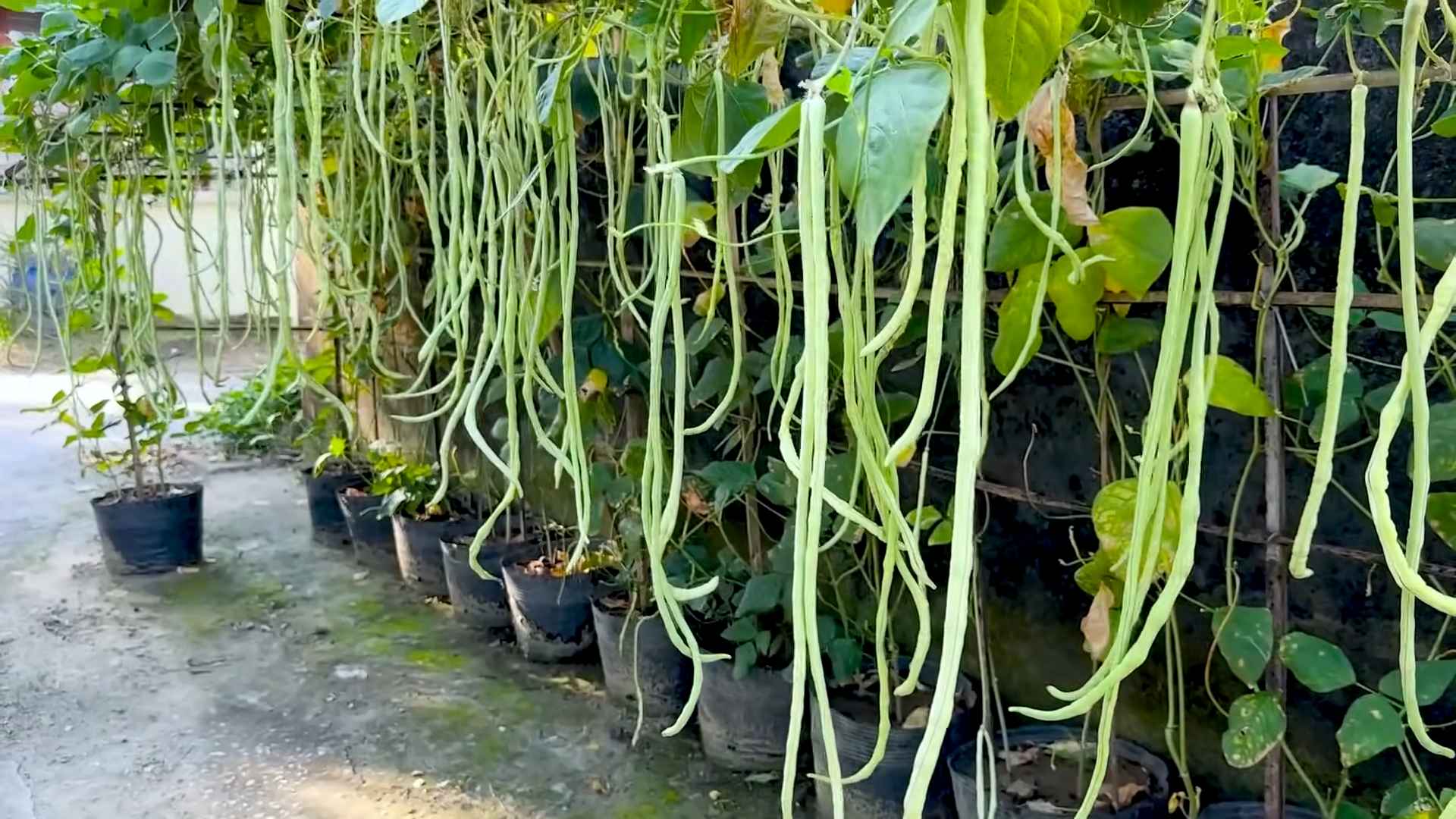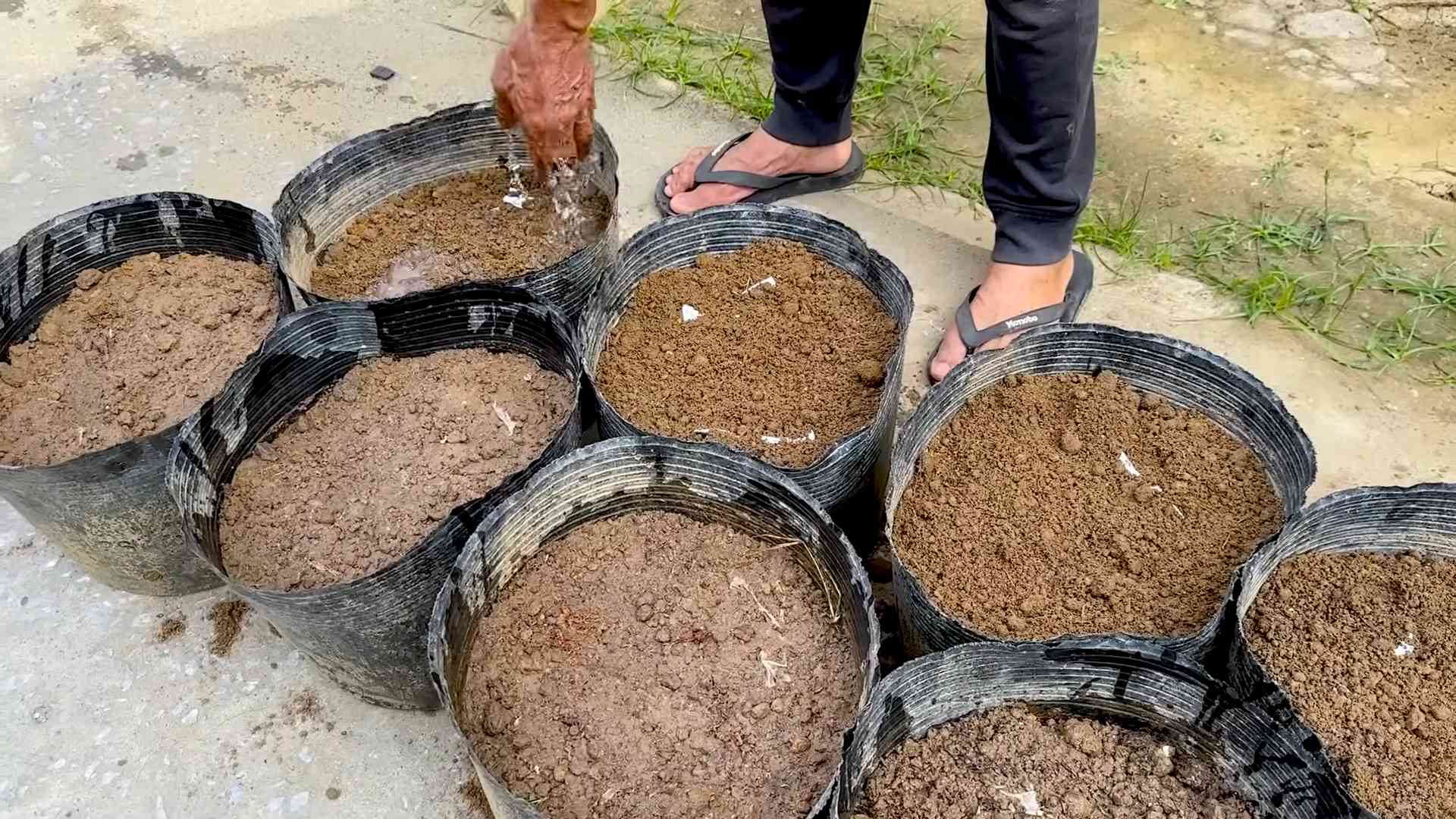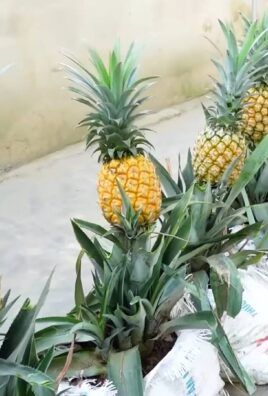Grow Yardlong Beans, and prepare to be amazed! Imagine harvesting beans that are literally a yard long – it’s not just a gardening feat, it’s a conversation starter! For centuries, these impressive legumes, also known as asparagus beans or Chinese long beans, have been a staple in Asian cuisine, adding a unique texture and subtly sweet flavor to stir-fries, salads, and more. Their history is deeply rooted in Southeast Asia, where they’ve been cultivated for generations, providing a vital source of protein and nutrients.
But why should you bother learning how to grow yardlong beans? Well, beyond the sheer novelty, these beans are incredibly productive and relatively easy to cultivate, even in smaller spaces. If you’re tired of the same old green beans and looking for a fun, rewarding, and delicious addition to your home garden, then you’ve come to the right place. I’m going to share some simple DIY tricks and hacks that will have you harvesting armfuls of these extraordinary beans in no time. Plus, growing your own food is incredibly satisfying, and knowing exactly where your food comes from is a huge bonus. Let’s get started and transform your garden into a yardlong bean paradise!

Growing Yardlong Beans: A DIY Guide to a Bountiful Harvest
Hey there, fellow gardening enthusiasts! Ever dreamt of harvesting beans that are literally a yard long? Well, dream no more! Growing yardlong beans (also known as asparagus beans or Chinese long beans) is surprisingly easy and incredibly rewarding. I’m going to walk you through everything you need to know, from seed to table, so you can enjoy these delicious and impressive veggies in your own backyard.
Choosing the Right Variety and Location
Before we get our hands dirty, let’s talk about picking the right yardlong bean variety and finding the perfect spot for them to thrive.
* Variety Selection: There are several yardlong bean varieties available, each with slightly different characteristics. Some popular choices include ‘Red Noodle’ (known for its beautiful red pods), ‘Chinese Red Noodle,’ and ‘Orient Wonder.’ Do a little research to see which variety is best suited for your climate and taste preferences. I personally love ‘Red Noodle’ because of its vibrant color and excellent flavor.
* Sunlight: Yardlong beans are sun-worshippers! They need at least 6-8 hours of direct sunlight each day to produce a good harvest. Choose a location in your garden that gets plenty of sunshine throughout the day.
* Soil: These beans prefer well-drained soil that is rich in organic matter. Before planting, amend your soil with compost or well-rotted manure to improve its fertility and drainage. A slightly acidic to neutral soil pH (around 6.0-7.0) is ideal. I always test my soil pH before planting anything new to make sure it’s just right.
* Support System: Yardlong beans are climbing plants, so they need a sturdy support system to grow on. You can use a trellis, fence, or even a teepee made of bamboo poles. Make sure your support structure is at least 6-8 feet tall to accommodate the bean’s vigorous growth.
Starting Your Yardlong Beans
Now for the fun part – getting those seeds in the ground! You can either start your yardlong beans indoors or direct sow them in your garden. I prefer direct sowing because it avoids transplant shock, but starting indoors can give you a head start, especially in cooler climates.
Direct Sowing (My Preferred Method)
1. Prepare the Soil: Loosen the soil in your chosen planting area and amend it with compost or well-rotted manure. Rake the soil smooth and remove any rocks or debris.
2. Sow the Seeds: Plant the seeds about 1 inch deep and 2-3 inches apart. If you’re planting in rows, space the rows about 2-3 feet apart. I usually plant two seeds per hole to increase the chances of germination.
3. Water Gently: Water the soil gently after planting to avoid disturbing the seeds. Keep the soil consistently moist until the seedlings emerge.
4. Thin the Seedlings: Once the seedlings are a few inches tall, thin them to one plant per hole. Choose the strongest and healthiest-looking seedling to keep.
Starting Indoors (For a Head Start)
1. Choose Your Containers: Use small pots or seed trays filled with a well-draining potting mix. I like to use biodegradable pots so I can plant them directly into the ground without disturbing the roots.
2. Sow the Seeds: Plant the seeds about 1 inch deep in the potting mix.
3. Water and Provide Light: Water the soil gently and place the containers in a warm, sunny location or under grow lights. Keep the soil consistently moist.
4. Harden Off the Seedlings: Before transplanting the seedlings into your garden, you need to “harden them off” to acclimate them to outdoor conditions. Gradually expose them to increasing amounts of sunlight and wind over a period of 7-10 days.
5. Transplant Carefully: Once the seedlings are hardened off, transplant them into your garden, spacing them about 2-3 inches apart. Be careful not to damage the roots during transplanting.
Caring for Your Yardlong Beans
Once your yardlong beans are established, it’s important to provide them with the care they need to thrive.
* Watering: Yardlong beans need consistent moisture, especially during hot, dry weather. Water them deeply and regularly, especially when they are flowering and producing pods. I usually water them in the morning to allow the foliage to dry before nightfall, which helps prevent fungal diseases.
* Fertilizing: While yardlong beans don’t need a lot of fertilizer, a light feeding of a balanced fertilizer every few weeks can help boost their growth and productivity. I prefer to use an organic fertilizer, such as compost tea or fish emulsion.
* Weeding: Keep the area around your yardlong beans free of weeds, which can compete for nutrients and water. Hand-pull weeds regularly or use a hoe to cultivate the soil.
* Pest and Disease Control: Yardlong beans are generally resistant to pests and diseases, but they can be susceptible to aphids, bean beetles, and fungal diseases. Inspect your plants regularly for signs of pests or diseases and take action promptly. I like to use organic pest control methods, such as insecticidal soap or neem oil. For fungal diseases, ensure good air circulation and avoid overhead watering.
* Training the Vines: As your yardlong bean vines grow, you’ll need to train them to climb your support structure. Gently guide the vines up the trellis or fence and tie them loosely with twine if necessary. This will help them stay organized and prevent them from sprawling on the ground.
Harvesting Your Yardlong Beans
The moment you’ve been waiting for – harvesting those impressive yardlong beans!
* Harvest Time: Yardlong beans are typically ready to harvest about 60-80 days after planting. The pods should be long, slender, and firm, but not too thick or bulging. They should snap easily when bent.
* Harvesting Technique: Use scissors or pruning shears to cut the beans from the vine, leaving a short stem attached. Harvest regularly to encourage continued production. The more you harvest, the more beans your plants will produce!
* Storage: Freshly harvested yardlong beans can be stored in the refrigerator for up to a week. For longer storage, you can blanch and freeze them.
Troubleshooting Common Problems
Even with the best care, you might encounter some challenges when growing yardlong beans. Here are a few common problems and how to address them:
* Poor Germination: If your seeds aren’t germinating, make sure the soil is warm enough and consistently moist. You can also try soaking the seeds in water for 24 hours before planting to improve germination rates.
* Yellowing Leaves: Yellowing leaves can be a sign of nutrient deficiency, overwatering, or pest infestation. Check the soil drainage, fertilize if necessary, and inspect the plants for pests.
* Lack of Pod Production: If your plants are growing well but not producing pods, it could be due to lack of pollination, insufficient sunlight, or extreme temperatures. Make sure your plants are getting enough sunlight and water, and consider hand-pollinating the flowers if necessary.
* Pest Infestations: Aphids, bean beetles, and other pests can damage your yardlong bean plants. Use organic pest control methods to keep them under control.
Enjoying Your Harvest
Now that you’ve harvested your yardlong beans, it’s time to enjoy them! These versatile beans can be used in a variety of dishes, from stir-fries and salads to soups and stews.
* Stir-Fries: Yardlong beans are a classic ingredient in Asian stir-fries. Simply chop them into bite-sized pieces and stir-fry them with your favorite vegetables and sauces.
* Salads: Add blanched or steamed yardlong beans to your salads for a healthy and flavorful boost.
* Soups and Stews: Yardlong beans can also be added to soups and stews for extra texture and nutrition.
* Grilled: Toss yardlong beans with olive oil, salt, and pepper, and grill them until tender-crisp.
Growing yardlong beans is a rewarding experience that will provide you with a bountiful harvest of delicious and unique vegetables. With a little bit of care and attention, you can enjoy these impressive beans in your own backyard. Happy gardening!

Conclusion
So, there you have it! Mastering the art of growing yardlong beans doesn’t require a green thumb blessed by the gardening gods. It’s about understanding their needs, providing the right support, and being patient. This DIY approach, from seed to table, offers a unique satisfaction that store-bought beans simply can’t replicate. Imagine the pride you’ll feel serving a dish featuring beans you nurtured from tiny seeds into those impressive, elongated wonders.
But why is this DIY trick a must-try? Beyond the sheer joy of gardening, growing your own yardlong beans offers several compelling advantages. Firstly, you have complete control over the growing process. You can choose organic methods, avoiding harmful pesticides and herbicides, ensuring a healthier and more flavorful harvest. Secondly, freshly picked yardlong beans are undeniably superior in taste and texture compared to those that have traveled miles to reach your grocery store. The crispness and sweetness are simply unmatched. Thirdly, it’s a fantastic way to connect with nature, reduce your carbon footprint, and even save money in the long run.
Looking for variations? Absolutely! Experiment with different varieties of yardlong beans. Some are known for their vibrant colors, while others boast unique flavor profiles. Consider companion planting to enhance growth and deter pests. Marigolds, for example, are excellent companions for yardlong beans, repelling nematodes and other unwanted visitors. You can also adjust the trellis system to suit your space and aesthetic preferences. A simple bamboo structure works wonders, or you can get creative with repurposed materials.
Don’t be afraid to get your hands dirty and embrace the learning process. Gardening is all about experimentation, and even if you encounter a few hiccups along the way, the rewards are well worth the effort. Remember to provide consistent watering, adequate sunlight, and a sturdy trellis for your yardlong beans to thrive.
We wholeheartedly encourage you to give this DIY trick a try. Start small, perhaps with just a few plants, and gradually expand your garden as you gain confidence. And most importantly, share your experience with us! We’d love to hear about your successes, challenges, and any unique tips you discover along the way. Post pictures of your bountiful harvest, share your favorite yardlong bean recipes, and inspire others to embark on their own gardening adventures. Let’s cultivate a community of passionate gardeners, one yardlong bean at a time. Growing your own food, especially something as unique as the yardlong bean, is a rewarding experience that connects you to the earth and provides fresh, healthy produce for your table. So, grab your seeds, prepare your soil, and get ready to enjoy the fruits (or rather, the beans) of your labor!
FAQ
What are the ideal growing conditions for yardlong beans?
Yardlong beans thrive in warm weather and require at least 6-8 hours of direct sunlight per day. The ideal soil temperature for germination is between 70-85°F (21-29°C). They prefer well-drained soil that is rich in organic matter. Before planting, amend the soil with compost or well-rotted manure to improve fertility and drainage. Consistent moisture is crucial, especially during flowering and pod development.
How do I build a suitable trellis for yardlong beans?
Yardlong beans are vigorous climbers and require a sturdy trellis to support their growth. The trellis should be at least 6-8 feet tall to accommodate their long vines. You can use various materials to build a trellis, such as bamboo poles, wooden stakes, metal fencing, or even repurposed materials like old ladders or branches. The key is to create a strong and stable structure that the beans can easily climb. Ensure the trellis is securely anchored in the ground to prevent it from toppling over in strong winds.
What are common pests and diseases that affect yardlong beans, and how can I prevent them?
Common pests that can affect yardlong beans include aphids, bean beetles, spider mites, and nematodes. To prevent pest infestations, practice good garden hygiene by removing weeds and debris that can harbor pests. Encourage beneficial insects like ladybugs and lacewings, which prey on aphids and other pests. You can also use organic pest control methods such as insecticidal soap or neem oil. Diseases that can affect yardlong beans include fungal diseases like powdery mildew and rust. To prevent these diseases, ensure good air circulation around the plants and avoid overhead watering. If diseases do occur, treat them with organic fungicides.
How often should I water yardlong beans?
Yardlong beans require consistent moisture, especially during flowering and pod development. Water deeply and regularly, ensuring the soil remains consistently moist but not waterlogged. The frequency of watering will depend on the weather conditions and soil type. In hot, dry weather, you may need to water daily, while in cooler, wetter weather, you can water less frequently. Check the soil moisture regularly by sticking your finger into the soil. If the top inch of soil feels dry, it’s time to water.
When and how should I harvest yardlong beans?
Yardlong beans are typically ready to harvest about 60-70 days after planting. Harvest the beans when they are young and tender, about 12-18 inches long. Use scissors or pruning shears to cut the beans from the vine, leaving a short stem attached. Harvest regularly to encourage continued production. Overripe beans will become tough and stringy.
Can I grow yardlong beans in containers?
Yes, yardlong beans can be grown in containers, but you’ll need to choose a large container that is at least 12 inches in diameter and 12 inches deep. Use a well-draining potting mix and provide a sturdy trellis for the beans to climb. Container-grown beans may require more frequent watering and fertilization than those grown in the ground.
What are some good companion plants for yardlong beans?
Companion planting can help improve the growth and health of yardlong beans. Good companion plants include marigolds, which repel nematodes and other pests; basil, which repels aphids and whiteflies; and rosemary, which deters bean beetles. Avoid planting yardlong beans near onions or garlic, as they can inhibit their growth.
How do I save seeds from yardlong beans for future planting?
To save seeds from yardlong beans, allow a few pods to mature completely on the vine. The pods will turn brown and dry out. Once the pods are dry, harvest them and shell the seeds. Spread the seeds out on a tray to dry completely for a few days. Store the dried seeds in an airtight container in a cool, dark, and dry place.
What are some delicious ways to prepare and cook yardlong beans?
Yardlong beans are incredibly versatile and can be used in a variety of dishes. They can be stir-fried, steamed, grilled, or added to soups and stews. They pair well with Asian flavors like soy sauce, ginger, and garlic. You can also use them in salads or as a side dish. Try stir-frying them with garlic and chili flakes for a simple and flavorful dish.
How do I deal with yellowing leaves on my yardlong bean plants?
Yellowing leaves on yardlong bean plants can indicate several issues. It could be due to overwatering or underwatering, nutrient deficiencies (especially nitrogen), pest infestations, or diseases. Check the soil moisture and adjust your watering accordingly. Fertilize the plants with a balanced fertilizer or a nitrogen-rich fertilizer. Inspect the plants for pests and treat them as needed. If you suspect a disease, treat the plants with an appropriate fungicide.




Leave a Comment